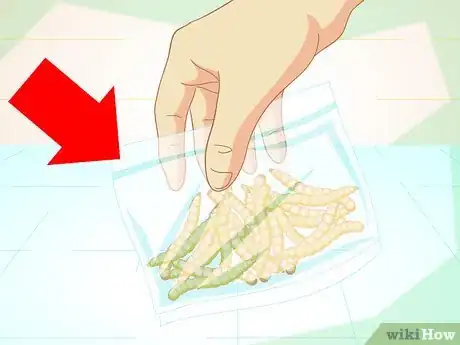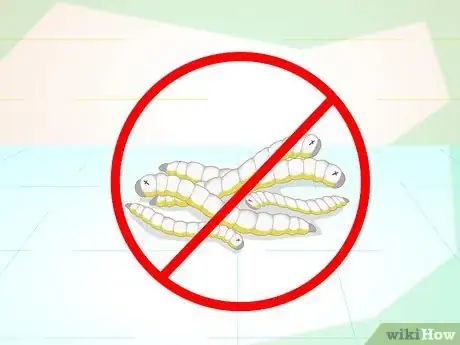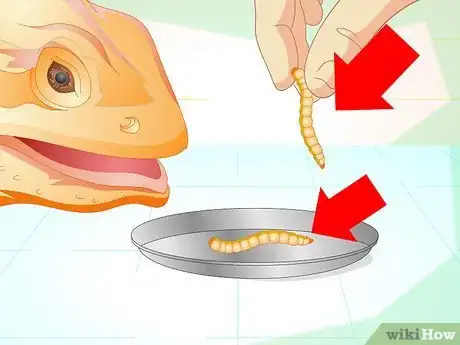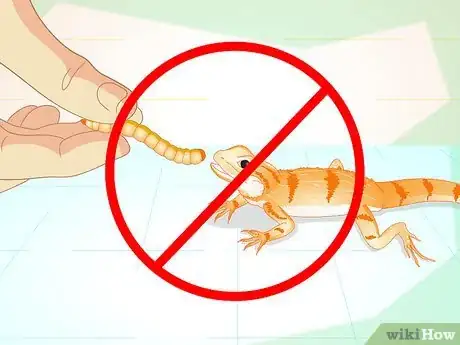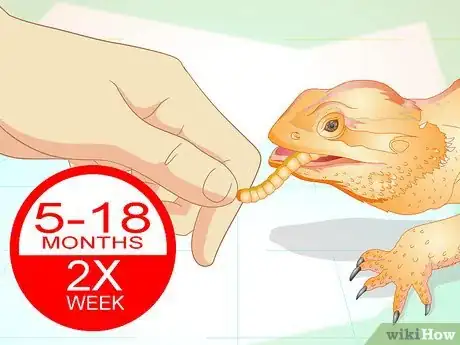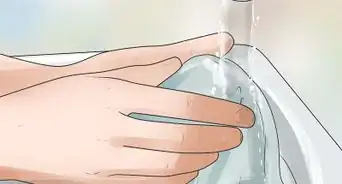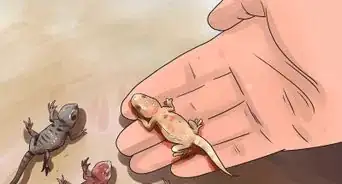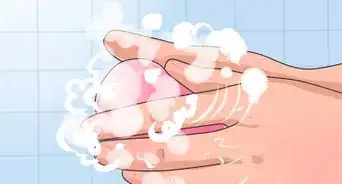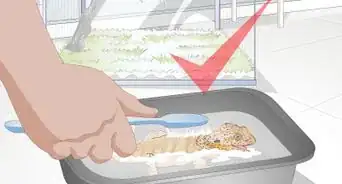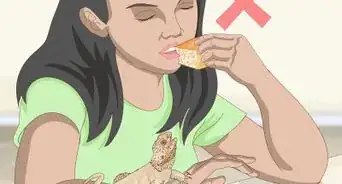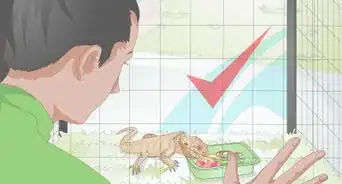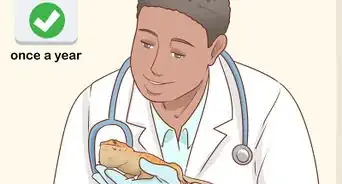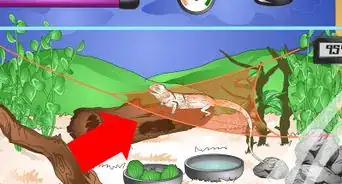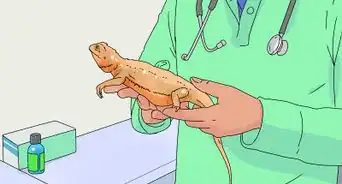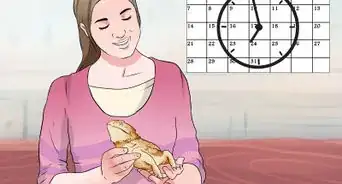This article was co-authored by Pippa Elliott, MRCVS. Dr. Elliott, BVMS, MRCVS is a veterinarian with over 30 years of experience in veterinary surgery and companion animal practice. She graduated from the University of Glasgow in 1987 with a degree in veterinary medicine and surgery. She has worked at the same animal clinic in her hometown for over 20 years.
There are 8 references cited in this article, which can be found at the bottom of the page.
This article has been viewed 103,145 times.
Mealworms can be a tasty treat for your bearded dragon. Once beardies reach the juvenile stage (five to 18 months), they can safely eat mealworms. Still, these insects should form only a very small part of your beardie’s diet. Balance mealworms with fruits, vegetables, and other insects.
Steps
Acquiring and Preserving Mealworms
-
1Purchase mealworms. You can buy mealworms in various sizes via mail order or at pet stores.[1] For example, Petco sells mealworms in sizes ranging from ¼ inch to 1 inch. The younger your dragon, the smaller the worm should be. In fact, if in doubt, always purchase a smaller worm.
- Mealworms consist of over sixty percent moisture, with smaller amounts of protein, fat, carbohydrate, and ash. They can be quite small, from a centimeter to almost two inches in length.[2]
- You can raise your own mealworms. See Raise Mealworms for more tips.[3]
-
2Keep your mealworms well-preserved. If you leave your mealworms at room temperature, they will become beetles. Your beardie should not eat these. You also may put mealworms in the refrigerator for several months, which will incite deep sleep. If you want the worms to be “active," place them in a plastic container with oatmeal flakes. Add bits of celery or apple for hydration. They will last for two weeks this way.[4]Advertisement
-
3Do not use dead mealworms. If you are preserving your mealworms and some die, do not feed them to your beardie. Dispose of them (preferably with gloves). Mealworms are appealing and exciting to eat because they are moving prey.
- Wear gloves when touching and removing dead mealworms.[5]
Feeding Mealworms to Your Beardie
-
1Dust the mealworm with calcium. When you feed your beardie mealworms, sprinkle calcium dust on the worms. At most, give calcium twice per week. This will help your dragon get needed nutrition plus necessary calcium.[6]
- Purchase calcium carbonate at drugstores.
- Grind the tablets into a powder.
- Use a sugar shaker to coat the worms.[7]
-
2Feed your dragon by hand. One way to bond with your bearded dragon is to feed him his food from your fingertips or from a pair of tweezers. Put part of a worm on your finger. He will use his tongue to lick it up. Be aware beardies are not aggressive, but an accidental bite could take the tip off your finger. So be careful with your fingers!
- Only give your dragon small amounts of food that he can eat in one day.[8]
-
3Place one or two worms on a bowl or plate. Place the mealworms in a bowl. Your dragon will eat from the bowl like a cat would eat.[9] Make sure the bowl’s edges are not too high. Another option is to put the food on a plate for easy access. While this might be a bit messy, the food could be easier to reach.
Knowing When to Give Your Beardie Mealworms
-
1Do not feed mealworms to baby beardies. Because mealworms have a rough outer skeleton, they are hard for babies to digest. In fact, if a baby eats a mealworm, he might get a dangerous intestinal blockage. Instead, feed babies smaller foods like crickets, fruit flies, and tiny wax worms.[10]
- If you notice your baby is having a hard time eating a certain food (e.g. she cannot get it in her mouth), remove the food from the cage. The food might be too big for your beardie to eat. For examples, beardies can only eat insects smaller than the distance between their eyes.[11]
-
2Offer juvenile dragons mealworms. One or two times weekly, you can feed mealworms to a juvenile dragon as a treat. Juvenile dragons are five months to eighteen months old. Still, you should aim to offer more vegetables than insects at this stage.[12]
-
3Give your adult dragon mealworms sparingly. Adults are dragons over 18 months in age. While your adult can now digest mealworms properly, he should be eating even more fruits and vegetables than when he was a juvenile.[15] Perhaps offer mealworms once per week and rotate mealworms with other insects.
- Aim for a balance of one fourth insects, three fourths fresh fruits and vegetables.
- Adult dragons also may eat mice or small lizards but feed these foods rarely.
- Adult dragons are prone to be overweight. Do not overfeed them.
- Female dragons may receive more food when they are breeding. [16]
- Remember mealworms are a treat — only offer a few to your beardie.
Expert Q&A
Did you know you can get expert answers for this article?
Unlock expert answers by supporting wikiHow
-
QuestionWhat is the best thing to feed a bearded dragon?
 Pippa Elliott, MRCVSDr. Elliott, BVMS, MRCVS is a veterinarian with over 30 years of experience in veterinary surgery and companion animal practice. She graduated from the University of Glasgow in 1987 with a degree in veterinary medicine and surgery. She has worked at the same animal clinic in her hometown for over 20 years.
Pippa Elliott, MRCVSDr. Elliott, BVMS, MRCVS is a veterinarian with over 30 years of experience in veterinary surgery and companion animal practice. She graduated from the University of Glasgow in 1987 with a degree in veterinary medicine and surgery. She has worked at the same animal clinic in her hometown for over 20 years.
Veterinarian
-
QuestionHow do you feed mealworms to bearded dragons?
 Pippa Elliott, MRCVSDr. Elliott, BVMS, MRCVS is a veterinarian with over 30 years of experience in veterinary surgery and companion animal practice. She graduated from the University of Glasgow in 1987 with a degree in veterinary medicine and surgery. She has worked at the same animal clinic in her hometown for over 20 years.
Pippa Elliott, MRCVSDr. Elliott, BVMS, MRCVS is a veterinarian with over 30 years of experience in veterinary surgery and companion animal practice. She graduated from the University of Glasgow in 1987 with a degree in veterinary medicine and surgery. She has worked at the same animal clinic in her hometown for over 20 years.
Veterinarian This will depend on your bearded dragon. If the beardie likes to feed themself, you can get special bowls with a lip and place the mealworms inside. Then the beardie can help himself but the worms can't wriggle away and escape. Alternatively, you can tweezer feed mealworms, just as you would locusts. Give mealworms as part of a balanced diet, so avoid feeding to excess as this could cause a bowel blockage.
This will depend on your bearded dragon. If the beardie likes to feed themself, you can get special bowls with a lip and place the mealworms inside. Then the beardie can help himself but the worms can't wriggle away and escape. Alternatively, you can tweezer feed mealworms, just as you would locusts. Give mealworms as part of a balanced diet, so avoid feeding to excess as this could cause a bowel blockage. -
QuestionWhat kind of worms can bearded dragons eat?
 Pippa Elliott, MRCVSDr. Elliott, BVMS, MRCVS is a veterinarian with over 30 years of experience in veterinary surgery and companion animal practice. She graduated from the University of Glasgow in 1987 with a degree in veterinary medicine and surgery. She has worked at the same animal clinic in her hometown for over 20 years.
Pippa Elliott, MRCVSDr. Elliott, BVMS, MRCVS is a veterinarian with over 30 years of experience in veterinary surgery and companion animal practice. She graduated from the University of Glasgow in 1987 with a degree in veterinary medicine and surgery. She has worked at the same animal clinic in her hometown for over 20 years.
Veterinarian
References
- ↑ http://www.sialis.org/raisingmealworms.htm
- ↑ http://www.bearded-dragon-food.com/
- ↑ https://www.wikihow.com/Raise-Mealworms
- ↑ http://www.bearded-dragon-food.com/
- ↑ https://www.wardsci.com/www.wardsci.com/images/Mealworm__Darkling_Beetles.pdf
- ↑ http://pets.petsmart.com/guides/bearded-dragons/feeding-your-beardie.shtml
- ↑ http://www.greenigsociety.org/vitamins.htm
- ↑ http://pets.petsmart.com/guides/bearded-dragons/feeding-your-beardie.shtml
- ↑ http://www.beardeddragoncare101.com/how-to-feed-bearded-dragon/
- ↑ http://www.beardeddragoncare101.com/how-to-feed-bearded-dragon/
- ↑ http://www.thebeardeddragon.org/bearded-dragon-diet.php
- ↑ http://www.beardeddragoncare101.com/how-to-feed-bearded-dragon/
- ↑ http://www.beardeddragoncare101.com/how-to-feed-bearded-dragon/
- ↑ http://www.bearded-dragon-food.com/
- ↑ http://www.beardeddragoncare101.com/how-to-feed-bearded-dragon/
- ↑ http://www.beardeddragoncare101.com/how-to-feed-bearded-dragon/
About This Article
To feed mealworms to a bearded dragon, start by sprinkling calcium dust over them so that your bearded dragon is getting all the nutrients it needs. Then, use your fingers or a pair of tweezers to hand feed the mealworms to your bearded dragon. If you're worried about being bitten, place the mealworms in a bowl or on a plate instead, and set them in front of your bearded dragon. Whichever method you use, only give your bearded dragon mealworms once or twice a week. For more tips from our Veterinary co-author, like how to preserve mealworms, read on!
